To create dynamic motion blur photos with your phone, start by selecting fast-moving subjects and contrasting backgrounds. Adjust your camera settings, focusing on slower shutter speeds (1/15 sec or longer) to capture movement. Try the panning technique, following your subject smoothly while shooting. For stationary scenes with moving elements, use a tripod for long exposures. Post-processing apps can enhance or add motion blur effects if in-camera methods aren't possible. Experiment with different techniques like radial, horizontal, or zoom blur to convey various types of motion. With practice and creativity, you'll soon master the art of capturing stunning, dynamic images that bring movement to life.
Understanding Motion Blur Photography
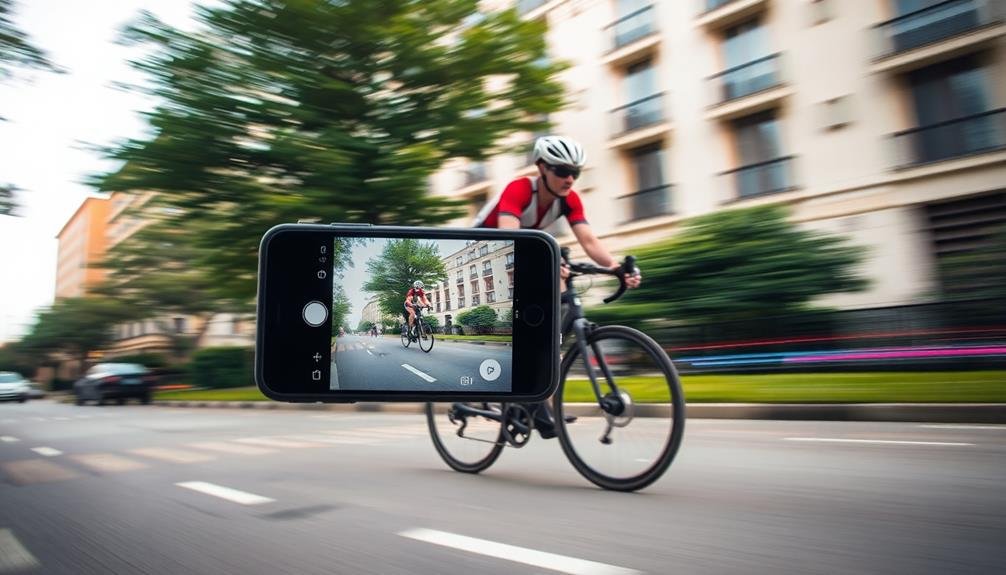
Motion blur photography is a technique that captures the essence of movement in a still image. It's a creative way to convey action, speed, and energy in your photos. When you use motion blur, you're fundamentally allowing moving subjects to become blurred while keeping stationary elements sharp. This effect can be achieved by using slower shutter speeds or panning your camera with the moving subject.
To understand motion blur, you need to grasp the relationship between shutter speed and movement. Faster shutter speeds freeze action, while slower speeds allow motion to be recorded as blur. The amount of blur depends on how fast your subject is moving and how slow your shutter speed is. You can create different types of motion blur effects, such as streaks of light from passing cars or the smooth flow of water in a stream.
When shooting motion blur photos with your phone, you'll need to overcome some limitations. Most smartphone cameras automatically set fast shutter speeds to avoid camera shake. However, with the right techniques and apps, you can override these settings and create stunning motion blur images even with your mobile device.
Choosing the Right Subject
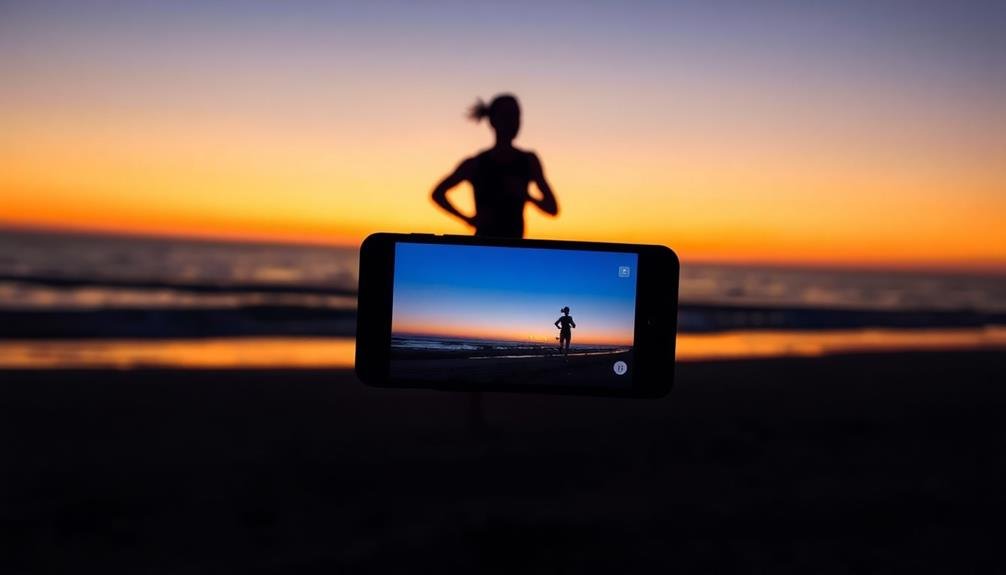
When selecting subjects for motion blur photography, you'll want to focus on fast-moving objects that create a sense of energy and dynamism.
Consider subjects like speeding cars, athletes in action, or even flowing water to capture compelling motion blur effects.
To enhance the impact of your shots, look for contrasting backgrounds that will make the blurred movement stand out and create a striking visual contrast.
Fast-Moving Objects
For dynamic motion blur photos, selecting the right fast-moving subject is essential. Look for objects that move quickly and predictably, such as cars, trains, or cyclists. These subjects create striking streaks of light and color when captured with a slow shutter speed.
Consider the direction of movement; subjects moving across your frame will produce more noticeable blur than those moving towards or away from you.
Urban environments offer plenty of opportunities for fast-moving subjects. Try capturing bustling city streets, where traffic and pedestrians create a sense of energy and flow. Sports events are another excellent source of rapid motion, with athletes sprinting, jumping, or performing acrobatic feats.
Even nature provides fast-moving subjects, like birds in flight or flowing water.
When choosing your subject, think about contrast and lighting. A brightly colored object against a darker background will create more impactful streaks.
Experiment with different times of day; sunset and nighttime can produce dramatic results with car headlights or illuminated buildings.
Contrasting Backgrounds
In addition to selecting fast-moving subjects, choosing the right background is essential for creating impactful dynamic motion blur photos.
You'll want to look for backgrounds that contrast with your subject, making it stand out and enhancing the sense of movement. Solid-colored or simple backgrounds often work best, as they don't compete with the blurred subject for attention.
Consider these background options for your motion blur shots:
- A plain white wall
- A dark, shadowy area
- A colorful mural or painted surface
- A textured surface like brick or wood
- A distant landscape with minimal detail
When you're setting up your shot, position yourself so that the background complements your subject's movement.
If you're photographing a runner, for example, a long stretch of uniform pavement can create a striking effect. For a cyclist, try shooting against a backdrop of trees or buildings that will blur into vertical lines as they pass by.
Camera Settings for Motion Blur
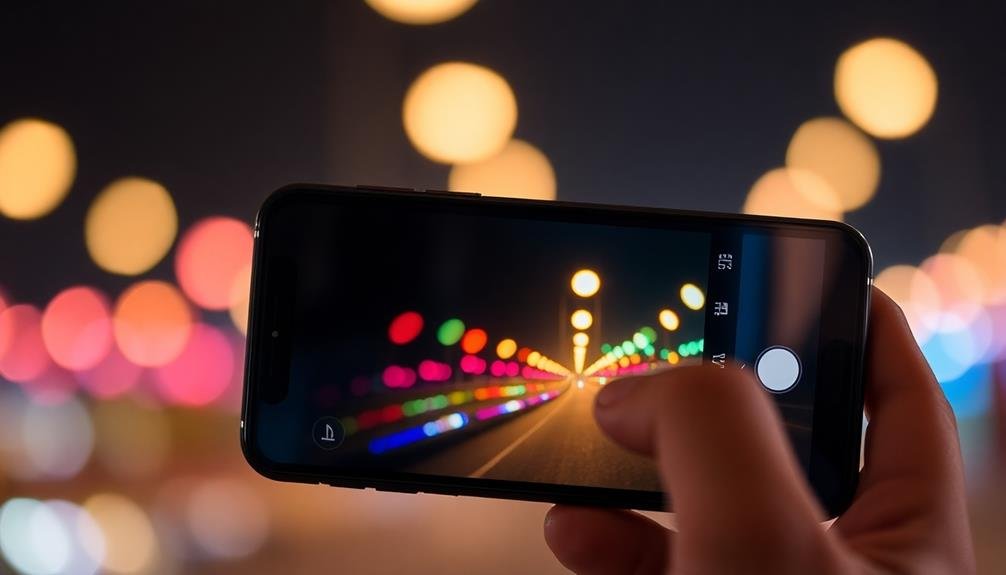
To capture stunning motion blur photos, you'll need to master your camera's settings.
Start by adjusting your shutter speed to a slower setting, typically 1/15 of a second or longer, depending on your subject's speed.
Don't forget to balance your ISO and aperture accordingly to maintain proper exposure while achieving the desired blur effect.
Shutter Speed Adjustments
Mastering shutter speed adjustments is essential for creating dynamic motion blur in your photos. On most smartphone cameras, you'll need to use a third-party app that allows manual control over shutter speed. Look for options like "Pro Mode" or "Manual Mode" in your camera settings.
To capture motion blur, you'll want to use slower shutter speeds. Start with 1/15 or 1/30 of a second and experiment from there. The longer the shutter remains open, the more motion blur you'll achieve.
Keep in mind that slower shutter speeds require a steady hand or a tripod to avoid camera shake.
When adjusting your shutter speed, consider the following scenarios:
- A runner sprinting past you
- Car headlights streaking through a nighttime cityscape
- A waterfall's cascading flow
- Spinning carnival rides at dusk
- Birds taking flight in a nature preserve
ISO and Aperture Considerations
While shutter speed is essential for motion blur, you'll need to take into account ISO and aperture settings to achieve the desired effect. ISO controls your camera's sensitivity to light, while aperture determines the depth of field and amount of light entering the lens.
For motion blur photos, keep your ISO as low as possible to minimize noise and maintain image quality. Start with ISO 100 or 200, and only increase if necessary. A lower ISO also allows for longer exposure times, enhancing the blur effect.
Aperture settings depend on your creative vision. A wider aperture (smaller f-number) lets in more light, which can be useful in low-light situations.
However, it also creates a shallower depth of field. For motion blur shots where you want both moving and stationary elements in focus, opt for a narrower aperture (larger f-number) like f/8 or f/11.
Panning Technique for Moving Subjects
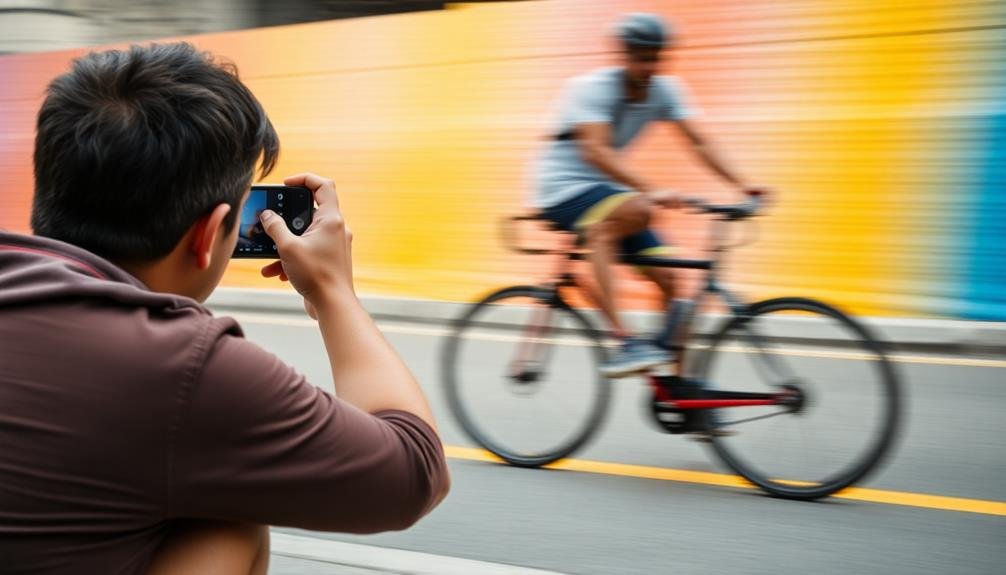
For capturing dynamic motion blur photos, the panning technique is a game-changer when shooting moving subjects. It involves following the subject with your camera as it moves, keeping it in focus while blurring the background. This creates a sense of speed and motion in your images.
To execute a successful pan, stand perpendicular to your subject's path. As it approaches, start tracking it with your phone's camera. Move your body smoothly, pivoting at the waist. Maintain a steady speed and continue the motion even after you've taken the shot. This follow-through is essential for a smooth blur effect.
Practice panning with various subjects to create striking imagery:
- A cyclist speeding down a busy street
- A colorful merry-go-round at a fair
- A sprinter crossing the finish line
- A bird in flight against a cloudy sky
- A sports car racing along a winding road
Experiment with different shutter speeds to achieve your desired effect. Slower speeds will create more blur, while faster ones will freeze more of the background. Start with 1/30th of a second and adjust from there.
Long Exposure With Tripod
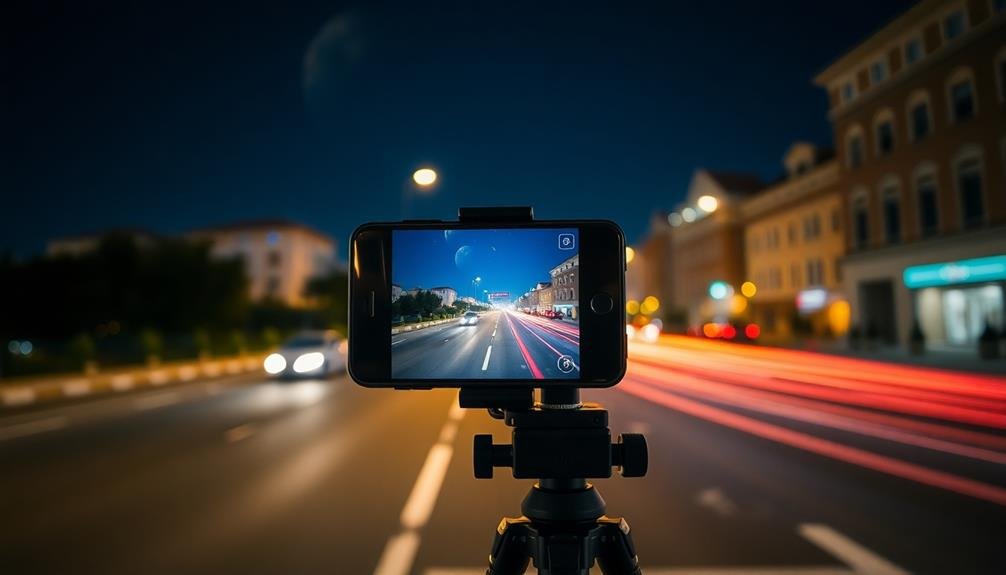
Long exposure photography with a tripod opens up a whole new world of creative possibilities for dynamic motion blur. By stabilizing your phone, you'll capture sharp stationary elements while blurring moving subjects, creating a striking contrast.
To begin, secure your phone to a sturdy tripod using a smartphone adapter. Choose a scene with both static and moving elements, like a busy street with stationary buildings. Set your phone's camera to manual mode or use a dedicated long exposure app. Select a slow shutter speed, typically between 1 and 30 seconds, depending on the desired effect.
Adjust your ISO to its lowest setting to reduce noise, and set your aperture to maintain proper exposure. Use your phone's self-timer or a remote shutter release to avoid camera shake when starting the exposure. Experiment with different shutter speeds to achieve varying degrees of motion blur.
For best results, shoot during low light conditions or use a neutral density filter to allow for longer exposures in bright light. Try capturing light trails from cars, flowing water, or moving crowds to create enchanting images that convey a sense of movement and time passing.
Post-Processing Motion Blur Effects
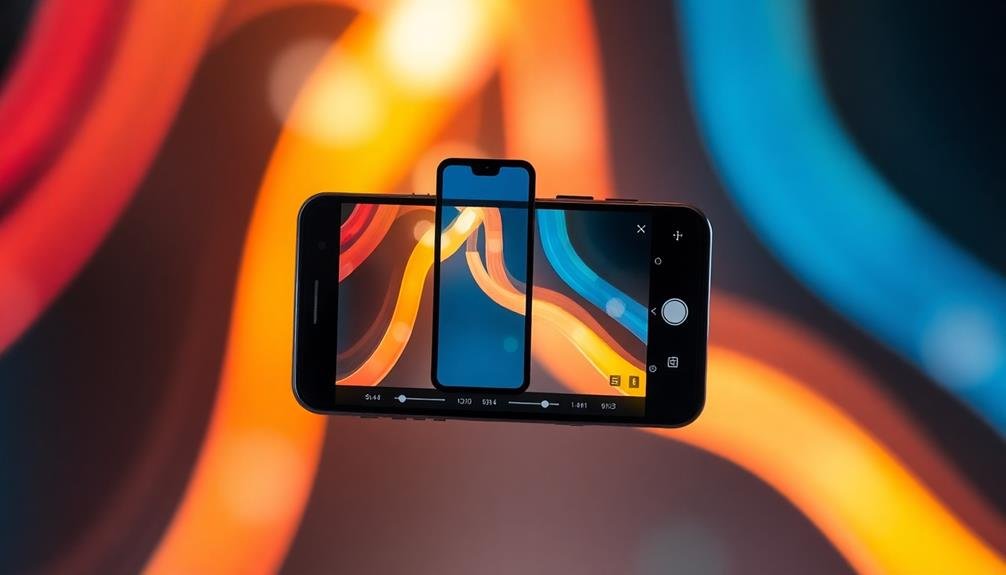
Post-processing techniques offer a powerful alternative for creating dynamic motion blur effects when in-camera methods aren't possible.
With the right apps and tools, you can transform ordinary photos into enthralling motion-filled images right on your phone.
Start by selecting a suitable base image with a clear subject and background. Then, use specialized motion blur apps or advanced photo editing software to apply directional blur effects.
You'll want to mask out your main subject to keep it sharp while blurring the surrounding areas. Experiment with different blur intensities and directions to achieve the desired effect.
Consider these creative ideas for post-processed motion blur:
- Radial blur emanating from a central point
- Horizontal streaks to suggest fast-moving traffic
- Vertical blur on falling objects or rain
- Circular blur for spinning or rotating subjects
- Zoom blur to create a sense of forward motion
Fine-tune your edits by adjusting opacity, blending modes, and selective masking.
Don't forget to enhance contrast and colors to make your motion blur effects pop.
With practice, you'll develop an eye for which images work best with post-processed motion blur, allowing you to create stunning, dynamic photos from even the most static scenes.
Frequently Asked Questions
Can I Create Motion Blur Effects With a Budget Smartphone?
Yes, you can create motion blur effects with a budget smartphone. You'll need to use your camera's manual mode or download specialized apps. Experiment with slower shutter speeds and practice panning techniques to capture dynamic, blurred movement in your photos.
How Do I Protect My Phone From Damage During Long Exposure Shots?
You'll want to secure your phone with a sturdy tripod to prevent drops. Use a remote shutter or timer to avoid camera shake. Consider a waterproof case for outdoor shots. Don't leave your device unattended in public areas.
Are There Any Apps Specifically Designed for Motion Blur Photography?
Yes, there are apps designed for motion blur photography. You'll find options like Slow Shutter Cam, Camera FV-5, and ProCam. These apps offer long exposure features and settings to help you capture stunning motion blur shots easily.
Can Motion Blur Be Added to Existing Photos Without Re-Shooting Them?
Yes, you can add motion blur to existing photos without re-shooting them. You'll find various photo editing apps and software that offer motion blur effects. They'll let you apply blur selectively or across the entire image.
How Do I Prevent Camera Shake When Using Slow Shutter Speeds?
To prevent camera shake with slow shutter speeds, you'll want to stabilize your camera. Use a tripod or rest it on a solid surface. If handheld, brace yourself, hold your breath, and use image stabilization if available.
In Summary
You've now got the tools to create stunning motion blur photos with just your phone. Remember, practice makes perfect. Don't be afraid to experiment with different subjects, settings, and techniques. Whether you're panning, using long exposure, or adding effects in post-processing, keep pushing your creative boundaries. With time, you'll develop an eye for capturing dynamic motion that'll make your images truly stand out. So get out there and start blurring!

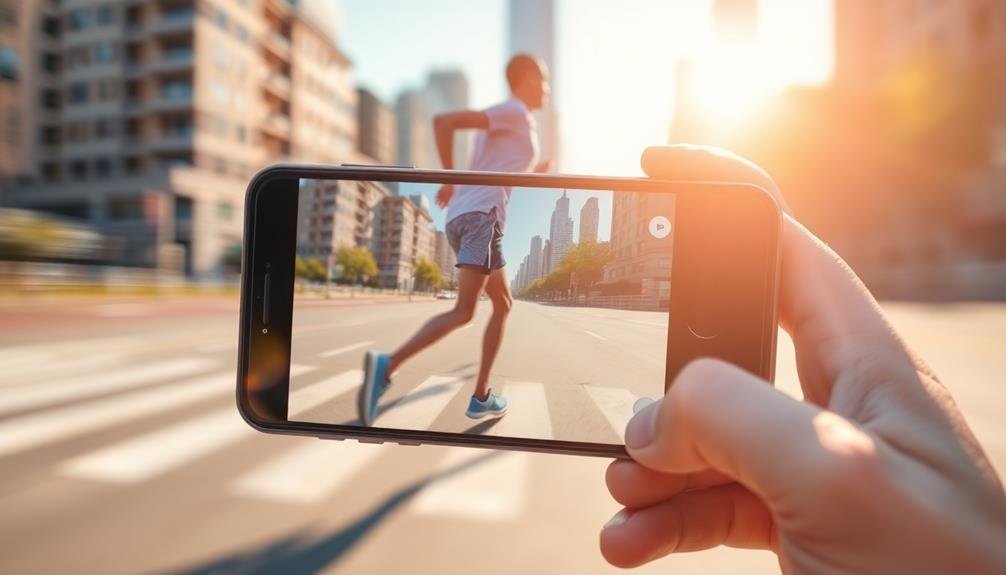



Leave a Reply